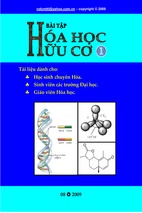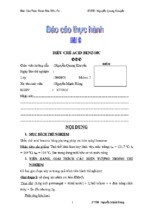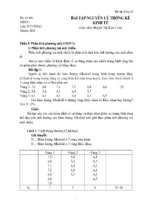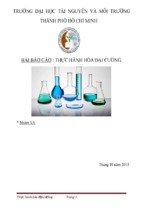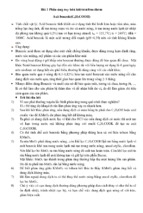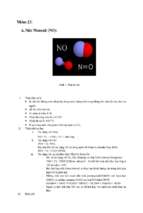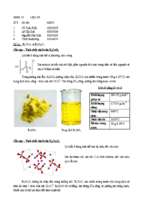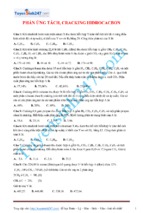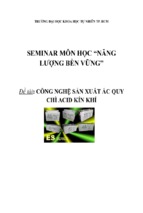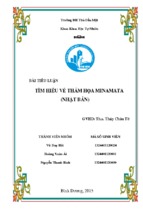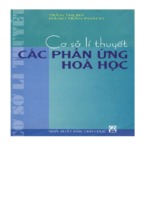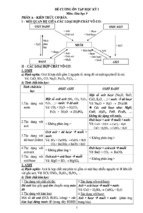Thi (Susan) Ngo
Analytical Chemistry
Dr. Kaufman
April 29, 2018
Final Project
Abstract
Soil from a local community-supported-agriculture (CSA) farm called City Roots was sampled
and digested to measure its concentration of potassium ions. One soil sample was tested on the
atomic absorption spectrometer, and the result was found to be 92.6 ± 4.1 ppm of potassium on
average. In addition, the gravimetric method was carried out by determining the weight of
potassium tetraphenylborate from the reaction of potassium ions with sodium tetraphenylborate.
This method found the concentration of potassium to be 79.0 ± 0.02 ppm; one value was omitted
by the Grubb test. Due to the insufficient trials, however, the data in this project were
inconclusive.
Introduction
Potassium is a crucial element that plants require to balance their physiological systems. For
example, potassium ions activate the enzymes for many biological processes such as regulating
the opening and closing of stomates and regulating the transport of nutrients in plants.1 Many
techniques have been designed to measure the concentration of potassium in soil in order to
ensure that the crop is developing in the best conditions. Atomic absorption spectrometry (AAs),
which is used to measure the concentration of an element, relies on the wavelength of light
absorbed by an element. Since the amount of the gaseous atoms is proportional to the absorbance
received on the readout, the concentration of the element in the sample can be calculated from
the working curve of the standards. In this project, the potassium content will be measured on
AAs at the wavelength of 404 nm. To increase the degree of accuracy of the first technique, a
second measuring technique will be implemented by weighing the filtered precipitate called
potassium tetraphenylborate formed from the reaction of potassium ions and sodium
tetraphenylborate.2 Knowing the gravimetric factor for potassium in the precipitate is 0.10912,
the amount of potassium in the sample will be calculated from the precipitate weight.2 The data
from the two methods will provide the information about the concentration of potassium in the
soil collected from City Roots.
Methods
Reagents and instrument
Potassium Chloride, Fisher Scientific. F.W. 74.56 g/mol;
Sodium tetraphenylborate, Sigma-Aldrich, MWL 342.22 g/mol;
Ammonium hydroxide, 28.23% w/v, Fisher Scientific;
1M Sodium hydroxide, Fisher Scientific;
Acetic acid glacial, 100%, Mallinckrodt;
Hydrochloric acid, 37 %, Carolina Biological Supply Company;
Atomic Spectrometer, Varian, SpecAA, 55b.
1M ammonium acetate solution
Acetic acid (8.90mL) was released from a 50mL class A buret into a beaker. After expelling the
rest of acetic acid, ammonium hydroxide (19.35 mL) was added to the buret and then slowly
released from the buret to the beaker. The solution was transferred to a 100-mL volumetric flask
and then diluted with distilled water to the mark.
Standards for atomic absorption spectrometry
Potassium chloride was dried in an oven at 230 F for two hours. The dried potassium chloride
(0.0479 g) was dissolved with 50 mL of distilled water in a 50-mL volumetric flask to make a
500 ppm standard. Fours standards at the concentrations of 20 ppm, 40 ppm, 60 ppm and 80 ppm
were made by diluting 1 mL, 2 mL, 3 mL and 4mL of the 500-ppm standard with the 1M
ammonium acetate solution to the 25-mL marks of volumetric flasks, respectively. A blank
standard contained only 25 mL of 1M ammonium acetate solution. All of the standards were
filled up with the 1M ammonium acetate solution to the 25-mL marks.
Soil digestion3
Soil was collected from City Roots and was dried in the oven at 230F for two hours. The dried
dirt was dissolved in 25 mL of the 1M ammonium acetate solution. The solution was left for 10
minutes at room temperature and then passed through filter paper into a 25-mL volumetric flask.
Atomic absorption spectrometry
The standards and the soil sample were tested on the atomic absorption spectrometer at 404 nm
to measure their absorbance.
Preparing 0.01M sodium hydroxide solution
A 1M sodium hydroxide solution was used to make 100 mL of 0.01 M sodium hydroxide
solution by transferring 1 mL of the 1M solution to a 100-mL volumetric flask and adding
distilled water to the mark.
Preparing 1% (w/v) sodium tetraphenylborate solution
Sodium tetraphenylborate (1g) was dissolved in 100 mL of 0.01M sodium hydroxide resulting in
a cloudy solution. This solution was placed in an ice-water beaker.
Precipitation of potassium tetraphenylborate
The digested samples and a 50 ppm potassium chloride solution were placed in 50-mL conical
flasks. Hydrochloric acid (2mL) was added to each solution.4 The two flasks were then placed in
ice-water beakers for 10 minutes.4 With a 20 mL volumetric pipette, 20 mL of the 1% sodium
tetraphenylborate solution was added to each solution.4 The flasks were placed in ice-water baker
for 10 additional minutes.4 Each solution was filtered through 30-mL weighed Gooch crucibles
with vacuum filtration.
The precipitate from the 50 ppm potassium chloride solution was dissolved in a boiling acetone
solution (20 mL).2 The flask was placed in an ice-water beaker for 30 minutes until all of the
crystals reformed.2 The filtered precipitate was dissolved in water to obtain a saturated aqueous
potassium tetraphenylborate solution.2 This saturated solution was added to the precipitates in the
crucibles to wash away impurities.2 The crucibles were left for 10 minutes at room temperature
after vacuum filtration and were then reweighed.2
Results
Atomic absorption spectrometer (AAS)
The equation y = mx + b of the best fit line of the absorbance versus the concentration of the
standards was obtained using the LINEST function. This equation was used to calculate the
concentration of the samples (x) with known absorbance values (y). The concentration of
potassium in the soil was shown in Table 1. The uncertainty of the concentration of potassium
was propagated by using the uncertainties of x values and the uncertainties of the glassware
involved in each step.
Volumetric determination using sodium tetraphenylborate salt
The mass of the precipitate, potassium tetraphenylborate, was determined by subtracting the
initial weight of the Gooch crucible from its final weight after filtration. Since 1 g of potassium
tetraphenylborate contains 0.10911 g of potassium, the amount of the precipitate allowed for the
determination of potassium in soil. The concentration of potassium in two soil samples was
calculated and shown in Table 1.
Trial 1 on
AAs
Trial 2 on
AAs
Sample 1 for precipitation
with sodium
tetraphenylborate
Sample 2 for precipitation with
sodium tetraphenylborate
95.5 ± 16.5
89.7 ± 16.5
79.0 ± 0.02
176.5 ± 19.21
Table 1: Concentration of potassium (ppm) in soil using two techniques
Discussion
Soil from a local CSA farm called City Roots was tested to determine its potassium
concentration. The first technique using atomic absorption spectrometry produced results of 95.5
± 16.5 ppm and 89.7 ± 16.5 ppm for potassium in soil. Since two values were close, an average
of these two results, 92.6 ± 4.1 ppm, was taken for this technique. The negative values of
absorbance for all the standards and the sample could be attributed to the fact that they were
prepared two days before the measurement on the atomic absorption spectrometer; thus, a small
portion of the solutions may have evaporated. As a result, it was likely that the instrument had
difficulties detecting such a relatively low concentration of potassium in the solutions.
The other technique was using sodium tetraphenylborate to precipitate potassium out of the
digested soil in ammonium acetate and hydrochloric acid. The procedure was primarily based on
the article written by Sporek and Williams, except that the step of preparing the wash solution
was based on the article written by Engelbrecht and McCoy. Among the four values obtained
from two techniques: 95.5 ppm, 89.7 ppm, 79.0 ppm and 176.5 ppm, the one of sample 2 in the
second technique was possibly an outlier. After performing the Grubb test with four values from
the atomic absorption spectrometry technique and the gravimetric technique, 176.5 (the
questionable number) was confirmed to be an outlier and removed. The source of errors in the
gravimetric technique could result from not using a desiccator to dry the solid in a dried
atmosphere as guided in the articles such that the precipitate may not have been fully dried
before weighing. Since there was only one measurement for the second technique, a t-test could
not be done to verify the data.
Conclusion
The potassium concentration in soil collected from City Roots farm was determined using two
techniques. There are 92.6 ± 4.1 ppm and 79.0 ± 0.02 ppm of potassium in soil using atomic
absorption spectrometry and gravimetry with sodium tetraphenylborate salt, respectively. Since
there were few trials conducted using the two techniques, no statistical test could be done to
confirm the accuracy of the data. In the future, more measurements should be performed to
determine the accurate concentration of potassium in soil, which is an essential nutrient in plants,
so that farmers can better understand how much more fertilizer they need to supply.
References
1. Functions of potassium in plants. Better crops with plant food. Vol. 82: 1-5 [Internet].
[cited 29 April 2018]. Available from https://www.ipni.net/ppiweb/bcrops.nsf/
$webindex/84CBB51751971AB3852568F000673A10/$file/98-3p04.pdf
2. Engelbrecht R. M. and McCoy F. 1956. Determination of potassium by a
tetraphenylborate method. Anal. Chem. 28 (11): 1772–1773.
3. Thakur R.K, Baghel S. S., Sharma G. D., Sahu R. K., and Amule P. C. Traning
programme on advances in agro-technologies for improving soils, plant and atmosphere
system [Internet]. [cited 29 April 2018]. Available from
http://jnkvv.org/PDF/SoilScience/Lab%20Manual/LabManual2011.pdf
4. Sporek K. and WIlliams A. F. 1955. The quantitative determination of Potassium as the
tetraphenylboron salt. The Analyst, vol. 80(950): 347.
- Xem thêm -

